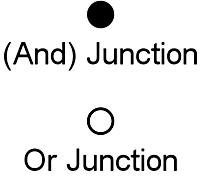|
Notation |
Role Names |
||
|
Composition |
Represents that an element consists of one or more other concepts. |
← composed of |
|
|
Aggregation |
Represents that an element combines one or more other concepts. |
← aggregates |
|
|
Assignment |
Represents the allocation of responsibility, performance of behavior, storage, or execution. |
← assigned to |
|
|
Realization |
Represents that an entity plays a critical role in the creation, achievement, sustenance, or operation of a more abstract entity. |
← realizes |
|
|
Dependency Relationships |
Notation |
Role Names |
|
|
Serving |
Represents that an element provides its functionality to another element. |
← serves |
|
|
Access |
Represents the ability of behavior and active structure elements to observe or act upon passive structure elements. |
← accesses |
|
|
Influence |
Represents that an element affects the implementation or achievement of some motivation element. |
← influences |
|
|
Association |
Represents an unspecified relationship, or one that is not represented by another ArchiMate relationship. |
associated with |
|
|
Dynamic Relationships |
Notation |
Role Names |
|
|
Triggering |
Represents a temporal or causal relationship between elements. |
← triggers |
|
|
Flow |
Represents transfer from one element to another. |
← flows to |
|
|
Other Relationships |
Notation |
Role Names |
|
|
Specialization |
Represents that an element is a particular kind of another element. |
← specializes |
|
|
Relationship Connectors |
Notation |
Role Names |
|
|
Junction |
Used to connect relationships of the same type. |
|
|
Created
June 30, 2023 17:56
-
-
Save peteraritchie/627e6ed7e381ecdbabb20e5b8034792c to your computer and use it in GitHub Desktop.
Sign up for free
to join this conversation on GitHub.
Already have an account?
Sign in to comment
